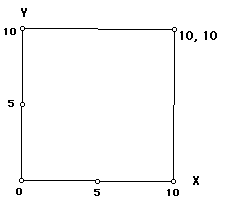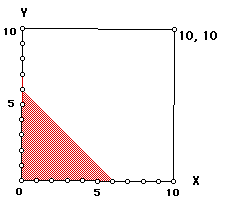
Objectives: The student will be able to determine
the
probability of an event using number lines, coordinate planes
and formulas for geometric figures.

For illustration of possible break, click here.
Although the break can occur along the line as above, the question
is concerned with only the breaks that determine specific parts,
mainly a part being greater than 8".
If the break were to occur near point A in the diagram above,
how far over could the break occur and still have a successful
outcome?
What if the break was to occur close to the point Y above?
For illustration of breaks close to A and Y, click
here.

In the diagram above, the green points represent
possible breaks for successful outcomes. In break that occurs
in the red area is successful. Therefore the P(randomly breaking
a 10" piece of linguine into two parts having one part be
more than 8") = 2+2 /10 = 2/5
What if we wanted both pieces of the linguine to
be more than 2" in length. We can use the same diagram but
we need to make some adjustments.
In order for the part containing point A to be greater than 2"
the break would have to occur to the right of the 2 in mark. On
the other end of the linguine, in order for the part containing
point Y to be more than 2" the break would have to occur
to the left of the 8 in mark.
For the illustration of breaks to meet the conditions just stated,
click here.
Let's look at a more applicable side to probability.
The Marta Transit System trains in Atlanta arrive/depart the station
every 15 minutes. Assuming that you arrive at the Indian Creek
station at a random time, what is the probability that you will
have to wait more than 5 minutes for a train. We can use a number
line to illustrate this problem.
The number line is divided into equal parts of 5 minute segments.
What would be a successful outcome? If you arrive at the 5 minute
marker, how long would you have to wait for a train?
That's right, 10 minutes, that would be a successful outcome to
our probability.
What if you arrived at the 10 minute marker? 11 minute marker?
Click here to illustrate the successful
outcomes.
Let's consider a different outcome. Most people do not like to
wait. Therefore, find the probability that you would have to wait
less than 5 minutes for the next train.
Click here for the illustration.
Notice the difference between the Marta train problems and the
linguine problems. With linguine a break could occur at either
end, but with time monitoring the trains, arrival is determined
from a time line left to right.
Slushies in the cafeteria are made in 8 gallon
containers. Once the level gets below 3, the slushies have a tendency
to be watery. What is the probability that when you go to the
cafeteria for your afternoon dessert, the slush machine will be
below 3 gallons.

That one was too easy. Let's make it more challenging. What is
the probability that when you buy your slushy today the container
will have between 3 and 4 gallons today?
Click here for illustration.
The probability that there will be between 3 and 4 gallons of
slushy in the container is 1/8. If you can divide the event into
equal parts, it is easier to express the probability.
Problem Set
1. The stop light at the corner of Mableton Parkway and Old Alabama
changes every 3 minutes. If you arrive at a random time, what
is the probability that you will wait more than 2 minutes?
2. Using the same scenerio as above, what is the probability that
you will have to wait less than 30 seconds?
3. You and a friend buy a large 16 ounce candy bar to divide.
You paid $0.75 and your friend paid $0.25. If you randomly break
the candy bar and receive a random piece, what is the probability
that you will get less of the candy bar than you paid for? (Hint:
Divide the candy bar by cost per 4 ounces)
4. French fries at Pop's Fast Food are made every 5 minutes. What
is the probability that if you arrive at a random time, your french
fries will be under the warmer less than 2 minutes?
Go
to Answers
Many times games are begun by asking each team
to pick a number between 0 and 10. The starting position is given
to the team that guessed the number closest to the moderators
number.
Supppose that the number the moderator guessed was Y and the number
you guess is X.
If X and Y can be two random number between 0 and 10, what is
the probability of X<Y?
First we must consider the sample space. The moderator has a sample
space of numbers between 0 and 10 and the player has a sample
space of numbers between 0 and 10. We may be tempted to state
the sample space as 10 or we are tempted to add these sample spaces
together for a total of 20. But both situations would give an
incorrect answer. We can not add these sample spaces together
because there is a connection between them.
It is easier to view this scenerio not on one number line, but
with two number lines using a coordinate plane.

The horizontal axis will represent the random
number x chosen by the moderator, and the vertical axis will represent
the random number y chosen by the player.
The first thing we should consider is the sample space. Because
both parties have the opportunity to choose the same number (for
example, 10 and 10), the sample space becomes a square, so that
all possiblities could be plotted on the graph.

The square is the sample space for our event.
We now must decide what area of the square will X<Y. One way
to look at it would be to consider some examples.
If the moderator chose 10 and the player chose 1, that would be
a success.
If the moderator chose 5 and the player chose 2, that would be
a success.
If the moderator chose 4 and the player chose 5, that would not
be a success.
This method would take forever, because we have not even started
to consider any rational numbers such as fractions.
The best solution is to view this as you would graphing an inequality.
First graph the inequality as an equation. x=y
Then shade the area that makes the sentence true. Click
here to graph the inequality.
From the picture, the shaded area is 1/2 of the total area. Therefore
the P(X<Y)= 1/2.
Let's consider another possibility. What is the probability that
the sum of the two numbers is less than 6?
We begin this problem with the same sample space as before. A
successful event is the combination of X and Y such that
Again, we begin by graphing the equation, x+y=6.
Click here for graph.
In order to find the probability of x+y<6 the area of the shaded
triangle and the area of the square are needed.
The area of the square is 10 x 10 = 100
The area of the triangle is 1/2 (base)(height) or 1/2 (6)(6) =
18.
So the P( X+Y<6) = 18/100 or 9/50

Finally, let's return to the
linguine for one more probability. What is the probability that
two breaks in the linguine will form 3 sides of a triangle?
First, we should divide our linguine into three segments. The
two breaks in the linguine will be at X and Y. The 10" linguine
will then be divided into parts with the given lenghts.

Our next step is to write three inequalities
that satisfy the conditions.
The sides of a triangle are such that the sum of any two sides
is greater than the third side. Therefore,

These can be simplified and graph using Algebra Xpresser. Go to Algebra Xpresser, simplify
the equations, then graph. You can adjust the axes of the graph
by clicking on the 3 picture on the left. This graph gives you
the option to change the axes to 0-10.
The successful outcomes are located in the area shaded by all
three inequalities.
The base and altitude of the shaded triangle is 5. The area of
the triangle is 1/2(5)(5).
The sample space of the event is 100. Therefore, the probability
of breaking linguine into three parts that form a triangle is

Problem Set
1. Find the probability that 10" piece of linguine could
be broken into two parts such that one part is at least twice
the length of the other.
2. Find the probability of two numbers X and Y from 0 to 10 are
randomly chosen such that 2X > Y.
3. Find the probability that a 10" piece of linguine could
be broken such that the three parts form an isosceles triangle.
Return
to Intro